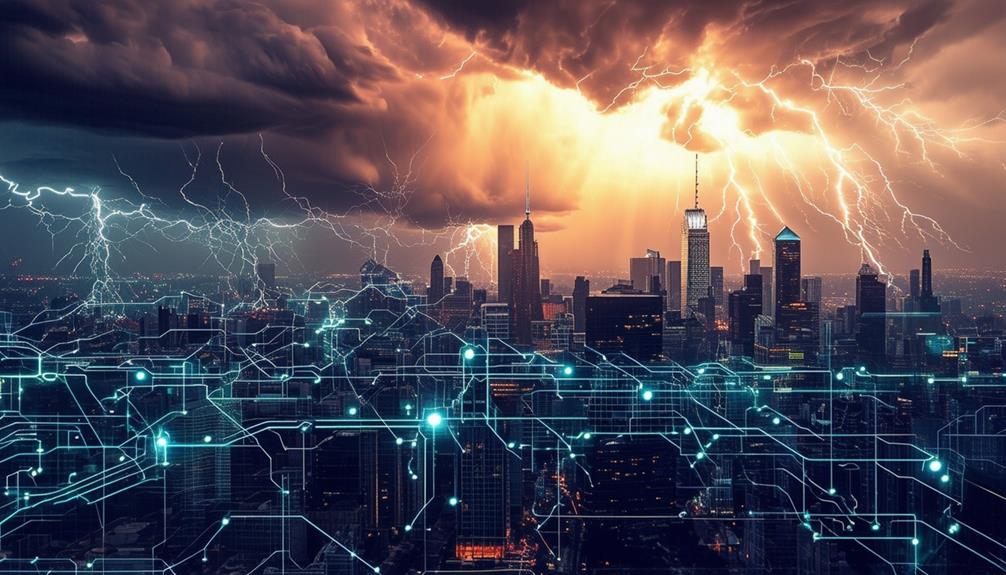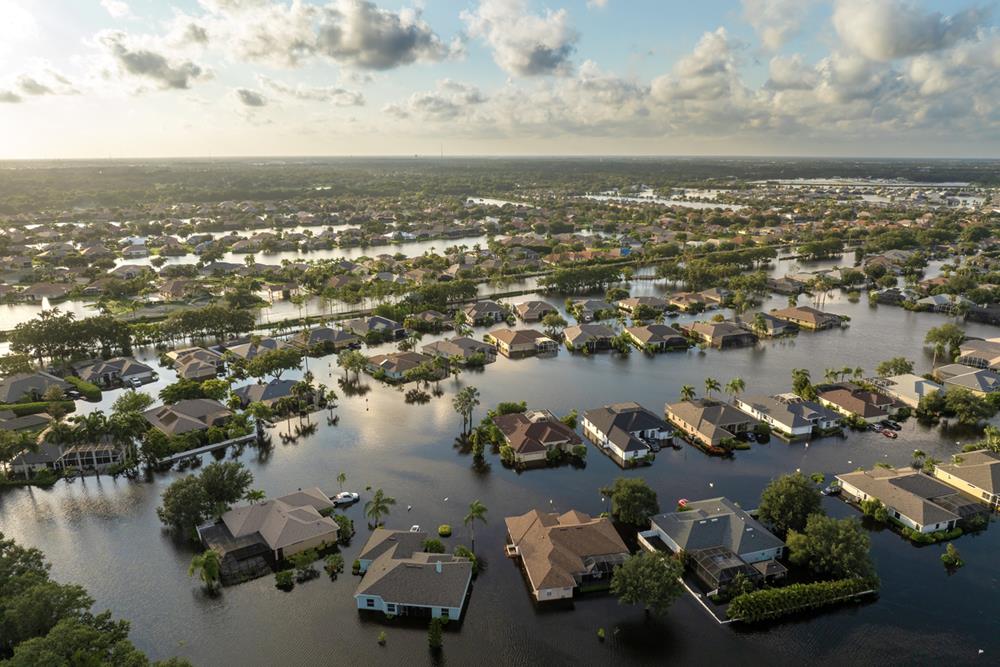EMP Threats: Natural Vs. Man-Made Sources

When considering EMP threats, it's crucial to examine both natural and man-made sources. Natural EMPs, such as solar geomagnetic storms, have the potential to incapacitate power grids and disrupt communications, exemplified by the Carrington Event of 1859. On the other hand, man-made EMPs, particularly those resulting from nuclear detonations, are deliberately engineered to target and disable critical infrastructure with precision. Each type poses distinct challenges, necessitating specific strategies for mitigation. What differentiates these threats, and how can we effectively defend against them? Let's explore the nuances and develop comprehensive approaches to mitigate their impacts.
Understanding EMP Threats

Understanding EMP threats involves recognizing their potential to originate from both natural events and man-made actions. An EMP can severely impact vital infrastructure, such as power grids, communication networks, and transportation systems, leading to disastrous consequences if not properly addressed.
Man-made EMPs, including High-Altitude Electromagnetic Pulses (HEMP), were first identified in 1962. These pulses occur when a nuclear device is detonated at high altitude, releasing a burst of electromagnetic energy. Although historical data on their effects is limited, the potential damage to vital infrastructure is significant. For instance, a HEMP could knock out power grids, disrupt telecommunications, and incapacitate critical services.
Natural EMP events, like geomagnetic storms resulting from solar activity, are considered more likely to occur. These natural events have demonstrated their ability to disrupt infrastructure, as seen in the historic Carrington Event of 1859 and more recent occurrences in Quebec and the U.S. These incidents highlight the importance of preparing for such threats. Understanding EMP threats is essential for ensuring the resilience of vital infrastructure, safeguarding against both natural and man-made sources.
Natural EMP Sources
Natural electromagnetic pulse (EMP) sources can be categorized into two main types: solar geomagnetic storms and lightning strikes. Solar geomagnetic storms, exemplified by the historic Carrington Event, have the potential to cause widespread disruptions to electrical grids and communication networks on a massive scale. These events can have far-reaching consequences, impacting a broad geographic area. On the other hand, lightning strikes, although more localized in nature, can still present substantial risks to electronic systems. The intense electrical discharge during a lightning strike can damage sensitive equipment and infrastructure, requiring protection measures to mitigate potential harm.
Solar geomagnetic storms and lightning strikes both underscore the importance of understanding and preparing for natural EMP events. By recognizing the threats posed by these phenomena and implementing appropriate safeguards, individuals and organizations can enhance the resilience of their systems and minimize the impact of electromagnetic disturbances. Vigilance, coupled with proactive measures, can help mitigate the risks associated with natural EMP sources and ensure the reliability of critical infrastructure in the face of such events.
Solar Geomagnetic Storms
Solar geomagnetic storms, caused by interactions between the solar wind and Earth's magnetic field, pose significant threats to modern infrastructure. These storms can induce Geomagnetic Disturbances (GMDs) that disrupt power grids, communication systems, and satellites. The historic Carrington Event in 1859, which severely disrupted telegraph services, highlights the potential impact of such events.
To understand the severity of this threat, consider the following:
- Grid Shutdowns: Regions such as Quebec, the U.S., and Canada have experienced grid collapses due to geomagnetic storms. For example, Quebec faced a major blackout in 1989, leaving millions without power.
- Real-World Consequences: In 2003, a solar storm caused a grid collapse in Malmo, Sweden, demonstrating the immediate impacts of GMDs on daily life and infrastructure.
- Recurring Threats: NASA estimates indicate that solar storms aren't rare occurrences, highlighting the necessity of fortifying our infrastructure against these natural electromagnetic pulse (EMP) sources.
Solar geomagnetic storms are a clear and present danger, necessitating proactive measures to mitigate their effects on our increasingly technology-dependent world.
Lightning Strikes Impact
Lightning strikes, an unpredictable natural source of electromagnetic pulses (EMP), can severely impact electronic systems and infrastructure. With approximately 25 million cloud-to-ground lightning strikes occurring annually in the United States, the potential for disruption is significant. Each strike generates a high-energy EMP capable of damaging power lines, transformers, and sensitive electronic equipment, leading to costly repairs and extended downtime for businesses and essential services.
To mitigate the damaging effects of lightning-induced EMPs, implementing robust lightning protection systems is essential. Surge suppressors can safeguard electronics from sudden energy surges, while grounding rods can safely divert electrical charges into the ground. These measures are crucial for protecting vulnerable infrastructure from unpredictable lightning strikes.
Given the frequency and intensity of lightning strikes, failing to take preventive action can be a costly oversight. Unprotected systems are at significant risk of EMP damage, which can disrupt daily operations and result in substantial financial losses. Therefore, recognizing the threat posed by lightning strikes and investing in effective EMP protection measures is vital to ensure the resilience of electronic systems and infrastructure.
Man-Made EMP Sources

Man-made EMP sources, such as nuclear detonations and targeted electronic attacks, can severely disrupt electronic systems. The threat from High-Altitude Electromagnetic Pulses (HEMP) generated by nuclear explosions is particularly significant.
When a nuclear weapon detonates in the mid-stratosphere, it emits gamma rays that interact with Earth's magnetic field, producing an intense electromagnetic pulse. This HEMP can affect large geographic areas, disabling power grids, communication networks, and other critical infrastructure.
Key points about man-made EMP sources:
- Nuclear HEMP: A nuclear explosion in the atmosphere generates a HEMP that can cause widespread disruption to electronic systems, affecting both civilian infrastructure and military operations.
- Intentional Electronic Attacks: Non-nuclear EMPs can be directed at specific critical systems, like financial institutions or government facilities, to create chaos and damage without traditional weaponry.
- Defense Measures: Robust defense strategies are essential to mitigate these threats. This includes hardening critical infrastructure and developing rapid-response protocols.
Understanding these threats underscores the importance of preparedness and defense against man-made EMP sources.
Historical EMP Events
When considering historical EMP events, the Carrington Event of 1859 and the Quebec blackout of 1989 are particularly notable. Both incidents resulted from powerful geomagnetic storms and caused significant disruptions. Understanding these events provides insight into the potential impact of future geomagnetic disturbances.
Carrington Event 1859
The Carrington Event of 1859 serves as a vivid reminder of the disruptive potential of powerful geomagnetic storms on technological systems worldwide. Triggered by a massive solar coronal mass ejection, this event caused one of the most intense geomagnetic disturbances on record. The immediate and profound effects underscored the vulnerability of technological infrastructure to such natural phenomena.
During the Carrington Event, telegraph systems globally faced severe disruptions. In some cases, the induced electrical currents were so strong that they sparked fires along telegraph lines. Remarkably, operators were able to send messages without batteries, relying solely on the currents induced by the geomagnetic storm. The event also produced spectacular auroras visible as far south as the Caribbean, a rare display that highlighted the storm's immense power.
Key impacts of the Carrington Event include:
- Telegraph Disruption: Telegraph systems were significantly disrupted, underlining the risks to communication infrastructure.
- Fires: Induced electrical currents sparked fires, demonstrating the potential for physical damage.
- Auroras: Auroras appeared in atypical locations, indicating the widespread reach and intensity of the storm.
Modern society continues to be at risk from similar geomagnetic disturbances, which could severely impact our electrical grids and communication systems.
Quebec Blackout 1989
The Quebec blackout of 1989 stands as a stark reminder of the devastating impacts that natural geomagnetic disturbances can have on modern infrastructure. Triggered by a powerful solar storm, this geomagnetically induced disturbance (GMD) plunged millions of residents in Quebec into darkness for about 9 hours.
If you were living in Quebec at the time, you'd have experienced widespread disruptions. Communication systems failed, transportation ground to a halt, and daily life was severely affected. This event highlighted the vulnerability of power grids to natural electromagnetic pulse (EMP) events like GMDs.
The Quebec blackout was more than just an inconvenience; it was a wake-up call. It made clear that even the most advanced infrastructures aren't immune to the forces of nature. The blackout showcased the potential for geomagnetic storms to cripple entire regions, disrupting critical systems and services relied upon daily.
EMP Impact on Infrastructure

Critical infrastructure is at significant risk from electromagnetic pulses (EMPs), which can disrupt everyday life and essential services. An EMP can expose vulnerabilities in infrastructure, leading to power outages and communication failures. These disruptions can halt vital services, causing chaos and economic instability.
When an EMP occurs, the following critical systems are particularly vulnerable:
- Electric Grid: EMPs can damage transformers and other key components, resulting in widespread blackouts. Without power, critical facilities such as hospitals and water treatment plants can come to a standstill.
- Telecommunications: EMPs can damage circuits in communication devices, causing the loss of phone, internet, and emergency services. This breakdown can severely hamper coordination during crises.
- Transportation Systems: Modern vehicles and traffic control systems rely heavily on electronics, which can be disabled by an EMP, leading to accidents, delays, and obstructed rescue operations.
The economic and societal impacts of such infrastructure failures are immense. Therefore, protecting these systems against EMP effects requires strategic hardening measures and resilient design. The potential for EMPs to disrupt vital services underscores the need for proactive mitigation and preparedness planning. Addressing these vulnerabilities is essential to ensure continuity and resilience against both natural and man-made EMP threats.
Defense Strategies
When considering defense strategies against EMP threats, prioritize grid fortification techniques and develop comprehensive national contingency plans. Effective preparation requires public-private collaboration to ensure the protection of all critical infrastructure. Implementing these strategies significantly mitigates risks from both natural and man-made EMP sources.
Grid Hardening Techniques
To safeguard the electric grid from EMP threats, it's essential to implement robust grid hardening techniques such as shielding components, installing surge protectors, and establishing grounding systems. These strategies are critical for defending against both natural and man-made EMP events.
Here are three effective grid hardening techniques to consider:
Shielding Components:
- Use materials like copper or aluminum to create Faraday cages around critical infrastructure. These cages block electromagnetic fields, protecting essential systems from EMP damage.
Installing Surge Protectors:
- Deploy surge protectors at strategic points within the grid to absorb and dissipate EMP energy. This helps prevent equipment damage and minimizes downtime.
Implementing Grounding Systems:
- Establish comprehensive grounding systems to divert EMP energy away from sensitive components. Effective grounding significantly reduces the impact of an EMP on grid infrastructure.
National Contingency Plans
National emergency plans focus on developing robust defense strategies to safeguard against both natural and man-made electromagnetic pulse (EMP) threats. These plans include fortifying the electric grid and establishing detailed response protocols. Presidential administrations have long recognized the importance of national resilience to electromagnetic threats, addressing the need for comprehensive emergency plans to mitigate the risks posed by EMP events.
In practice, these plans emphasize preparedness by ensuring that critical infrastructure, such as the electric grid, is fortified against potential EMP attacks. The increasing concerns about the potential use of EMP weapons have intensified efforts to develop effective defense strategies. By concentrating on national resilience to electromagnetic disruptions, these strategies aim to minimize the impact of such events on daily life and essential services.
Moreover, these defense strategies are developed through collaboration among various government agencies, utilities, and the scientific community. This cooperative approach ensures that the plans are detailed, feasible, and effective. Creating and implementing these national emergency plans is crucial for protecting against the diverse threats posed by EMPs.
Public-Private Collaboration
Building national resilience against EMP threats requires robust public-private collaboration to address vulnerabilities in critical infrastructure. Government agencies, utilities, industry partners, and academic institutions must work together to implement comprehensive EMP defense measures that protect against both natural and man-made electromagnetic disturbances.
A coordinated approach is essential to effectively mitigate the impact of EMP events on national security and infrastructure. Public-private partnerships can significantly enhance the resilience of key systems by pooling resources and expertise.
The following components are critical for this effort:
- National Public Warning System: Ensure that all sectors are integrated into this system to provide timely alerts and coordinated responses during an EMP event.
- EMP Commission Recommendations: Implement strategies proposed by the EMP Commission to safeguard critical infrastructure and improve preparedness.
- Resource and Expertise Sharing: Foster collaboration between public and private sectors to share insights, technologies, and best practices for strengthening EMP defenses.
EMP Testing Techniques

Effective EMP testing techniques are crucial for ensuring that critical systems can withstand both natural and man-made electromagnetic pulse (EMP) events. There are two primary methods for EMP testing: induced pulse simulation and threat pulse simulation. These techniques help evaluate the resilience of technology and infrastructure against EMP events.
Overview of EMP Testing Techniques:
| Technique | Purpose |
|---|---|
| Induced Pulse Simulation | Evaluate equipment susceptibility through controlled surges. |
| Threat Pulse Simulation | Mimic real EMP events to assess infrastructure resilience. |
| Low-Level Pulses | Understand response characteristics of systems. |
| High-Energy Pulses | Simulate real threat conditions. |
| Current Clamp | Induce pulse simulation with targeted surges. |
- Induced Pulse Simulation: This method is particularly useful for testing the vulnerability of specific equipment to EMP events in a controlled environment. Using a current clamp, controlled surges are generated to assess how well the equipment withstands these conditions.
- Threat Pulse Simulation: This technique mimics actual EMP events to evaluate the overall resilience of critical infrastructure, providing a comprehensive assessment of potential vulnerabilities.
Both testing methods are essential for enhancing preparedness and resilience against EMP threats, whether natural or man-made.
Government Initiatives
The U.S. government frequently implements robust initiatives to protect critical infrastructure from EMP threats, crucial for national security and the uninterrupted operation of essential services. By collaborating with various agencies, efforts focus on fortifying the electric grid and developing comprehensive national contingency plans.
Key initiatives include:
- Executive Orders and Recommendations: These directives aim to enhance the resilience of critical infrastructure against EMP threats, providing a framework for preparedness and defense strategies.
- Interagency Collaboration: Agencies such as the Department of Defense work together to implement protective measures, ensuring a unified approach to both natural and man-made EMP threats.
- Research and Development: Continuous R&D efforts focus on improving resilience and response capabilities. By investing in advanced technologies and methodologies, the government enhances its ability to mitigate the impact of EMP events.
These initiatives underscore the importance of a proactive stance in defending against EMP threats. By prioritizing national security and leveraging the expertise of multiple agencies, the U.S. is better equipped to address and mitigate the risks associated with EMPs.
Public Awareness and Education

Public Awareness and Education
While government initiatives are crucial for safeguarding against EMP threats, raising public awareness and educating individuals is equally essential for comprehensive preparedness. You play a vital role in driving mitigation efforts by understanding the potential consequences of EMP events. Whether the source is natural or man-made, being informed empowers you to support initiatives aimed at protecting our critical infrastructure.
Understanding the differences between natural and man-made EMP sources can inform targeted education strategies. For instance, an executive order may mandate specific actions to protect the grid from solar flares, while other measures might focus on shielding against malicious attacks. By grasping these distinctions, you can better advocate for relevant protections and community preparedness.
Promoting EMP awareness isn't just about recognizing the risks; it's about fostering a proactive approach to readiness and response efforts. Equip yourself and others with knowledge about EMP threats to ensure your community is prepared. Simple steps like securing backup power sources and understanding emergency protocols can make a significant impact.
Collaboration and Partnerships
To effectively combat EMP threats, collaboration among government agencies, utilities, industries, and citizens is crucial. By fostering robust partnerships, we can create and implement effective EMP mitigation strategies that protect critical infrastructure and enhance overall resilience.
Public-private partnerships play a vital role in this effort. They enable various sectors to pool their resources, expertise, and funding.
Here's how you can contribute to strengthening these partnerships:
- Engage in Government Initiatives: Participate in programs led by agencies such as DHS and MITRE, which focus on evaluating and addressing EMP threats at the national level. These collaborations ensure cohesive and coordinated efforts.
- Support Utility and Industry Collaboration: Encourage local utilities and industries to collaborate on joint initiatives. These partnerships can develop innovative solutions and share best practices for EMP protection.
- Promote Community Involvement: Stay informed and support local efforts to build resilience. Communities that work together can better prepare for and respond to EMP events.
Conclusion
You now have a solid understanding of EMP threats, both natural and man-made, and their potential impacts on infrastructure. Staying informed and proactive is essential.
By understanding these threats, supporting government initiatives, and promoting public awareness, you can help build resilience against EMP disturbances.
Collaboration and partnerships are crucial in safeguarding our critical systems. Act now to protect our future.




